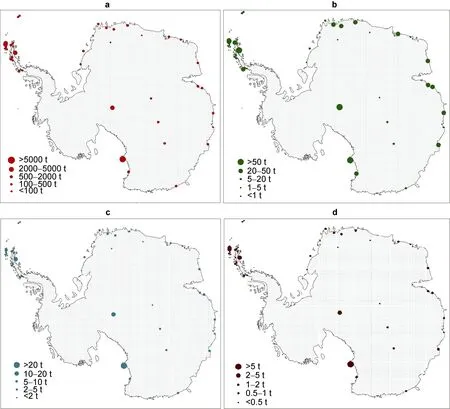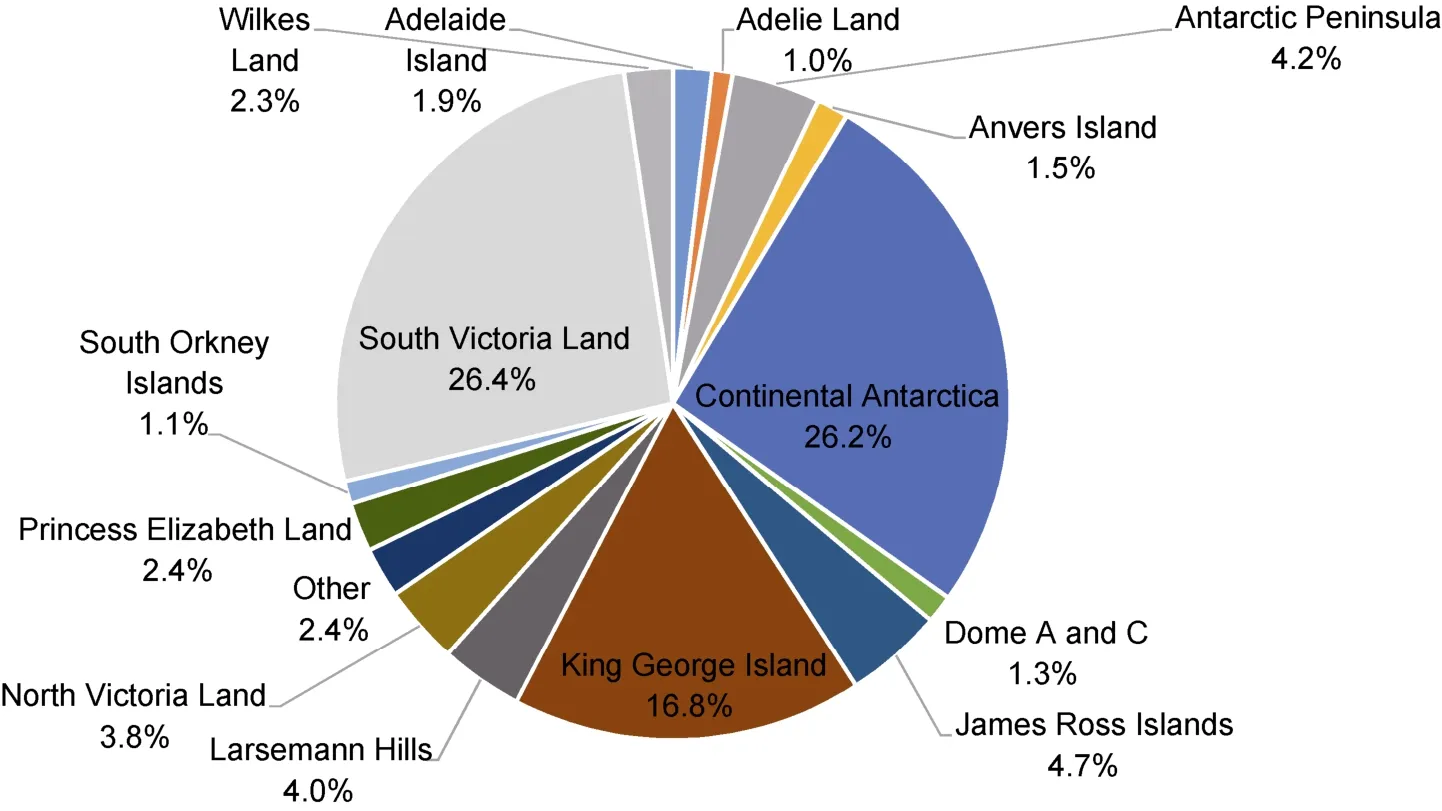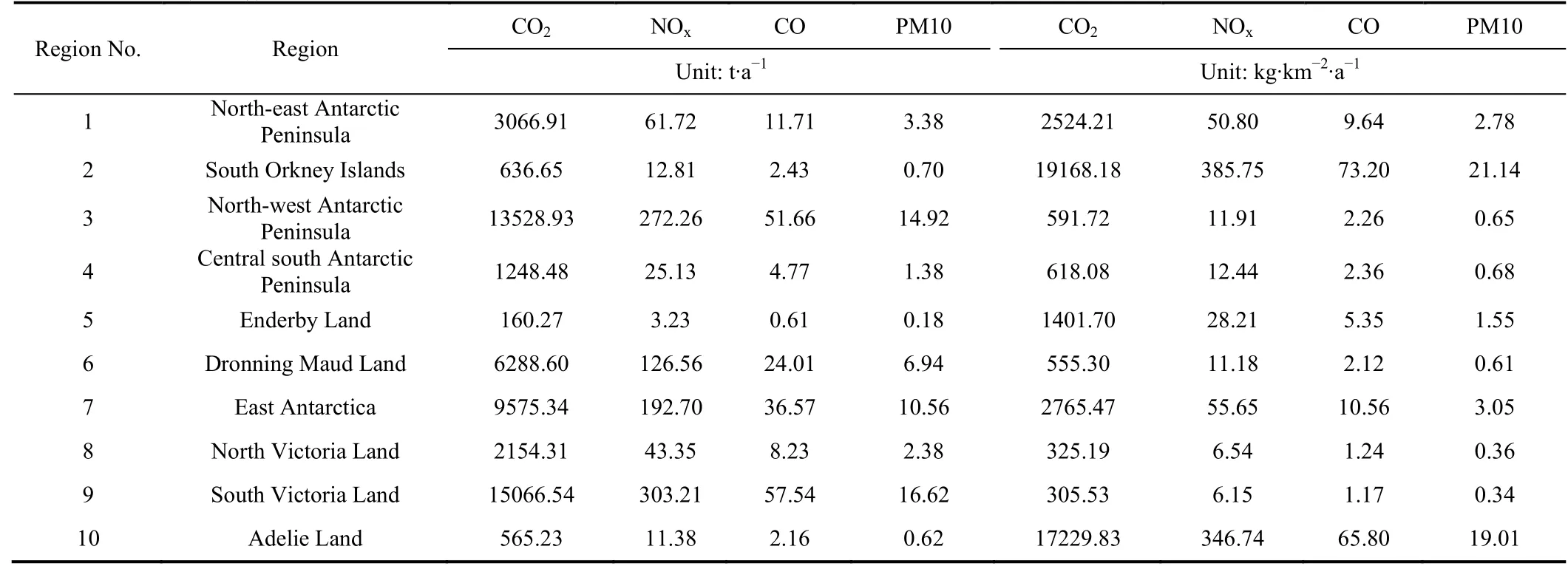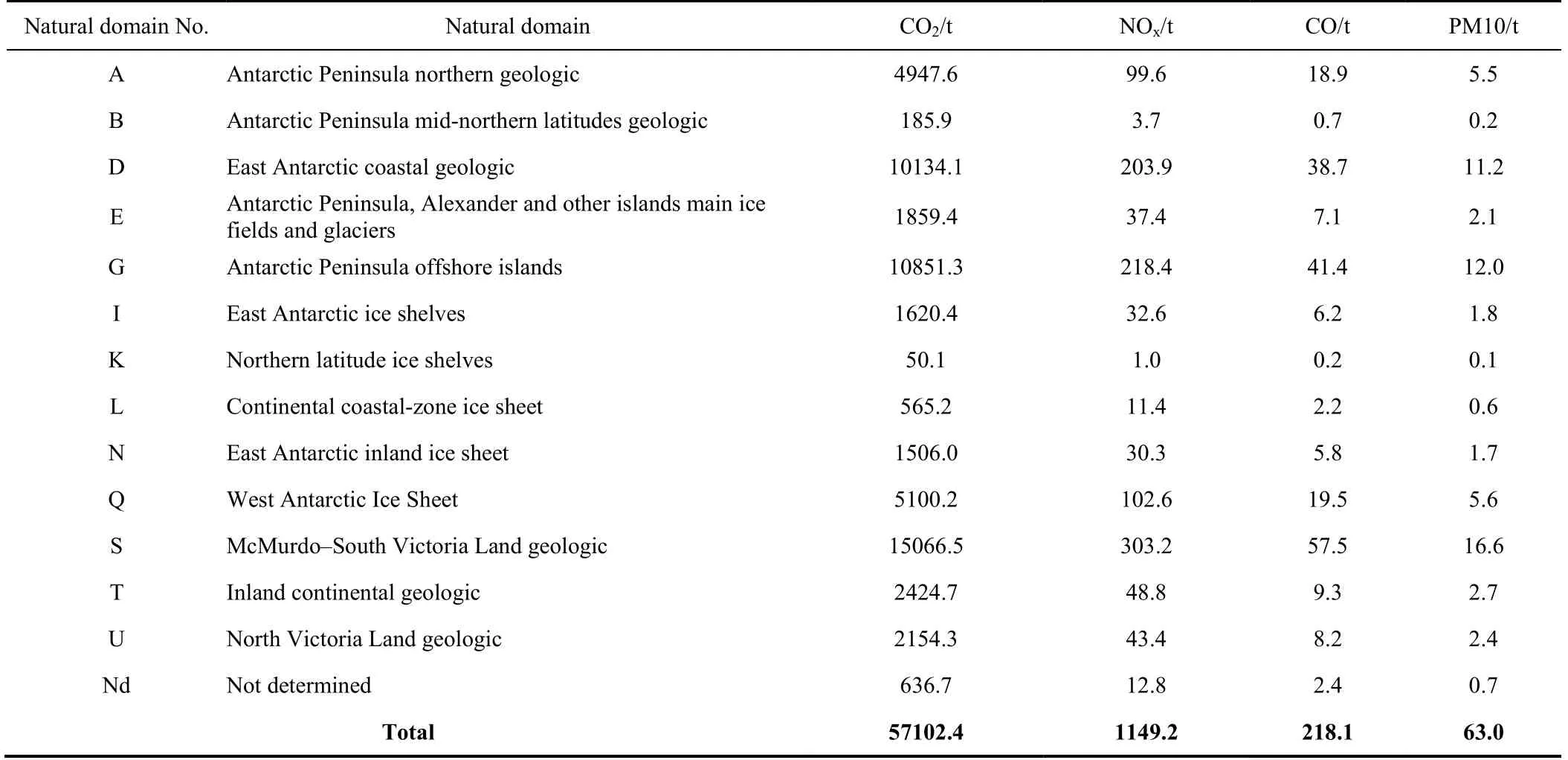Air pollutants and greenhouse gases emission inventory for power plants in the Antarctic
2020-04-12SergeyKAKAREKA
Sergey KAKAREKA
Institute for Nature Management,National Academy of Sciences of Belarus-Laboratory on Transboundary Pollution,Skoriny 10 Minsk 220076,Belarus
Abstract Emissions of air pollutants and greenhouse gases into the atmosphere in Antarctica from power plants with diesel generators (the main sources of energy at Antarctic research stations and the main stationary sources of anthropogenic emissions in the Antarctic) were assessed.A bottom-up approach was used to compile an emission inventory for the Antarctic.This involved estimating emissions at various spatial levels by sequentially aggregating estimate emissions from point emission sources.This is the first time this approach has been proposed and used.Emissions of CO2,NOx,particulate matter (PM10),and CO in the modern period were estimated at the research station,geographic region,natural domain,biogeographic region,continent section,and whole continent scales.Yearly emissions are presented here,but the approach allows emissions at different averaging periods to be estimated.This means mean or maximum yearly,monthly,daily,or hourly emissions can be estimated.The estimates could be used to model pollutant transmission and dispersion,assess the impacts of pollutants,and develop emission forecasts for various scenarios.
Keywords air pollutants,Antarctica,diesel generator,emission inventory,greenhouse gases,station
1 Introduction
Assessing pollutant and greenhouse gas inputs to the atmosphere is essential when assessing the effects of pollutants and greenhouse gases on the environment.Environmental air impacts in a particular area are determined by level of emissions from local sources and transboundary transmission.Compiling an emission inventory is the main way of estimating local emissions.Emission inventories at levels from a single enterprise (site) to the global scale are regularly compiled.Examples of emission inventories include EDGAR (Emission Database for Global Atmospheric Research),WebDab (the EMEP emission database),and AMAP/UNEP inventories (AMAP/UNEP,2013,2018;Crippa et.al.,2019;WebDap,2020).Antarctica is usually excluded from emission inventories because of its location,the regulations that apply and the natures of activities that occur there,and other features.Only two emission inventories for Antarctica have been published in more than three decades.One was a sulfur and heavy metal emission inventory for late 1980s (Boutron and Wolff,1989) and the other was a sulfur emission inventory for 2004–2005 (additionally carbon monoxide,carbon dioxide,Hg and Pb emissions were also estimated) (Shirsat and Graf,2009).Inventories for aggregated emission source sectors for the whole continent of Antarctica were presented in these publications.The inventories indicated that four categories of sources were the main contributors to pollutant emissions.These were diesel power plants (and heating systems),land transport,aviation,and shipping.No systematic data are available for emissions at the Antarctic region,oasis,other territorial division,or station level.Emissions have not been estimated for multiple consecutive years (like in the EDGAR and EMEP inventories for example).
In this study,a method for compiling a bottom-up air pollutant and greenhouse gas emission inventory for Antarctica was developed and emissions at different spatial levels in Antarctica were estimated.The study area was the area south of the latitude 60° S.According to COMNAP (2017a),there are 76 active permanent or seasonal stations in the study area.There are also field camps,refuges,runways,and other sites at which low-power energy sources are used.These small sites are not considered in this study.
2 Methods and materials
Emissions of pollutants to the air can be assessed using various methods.Emission factors combined with activity parameters are traditionally used to compile emission inventories at different spatial scales–from city to global.Emission factors are usually expressed in units of pollutant mass emitted per unit of product mass or energy produced (e.g.,g·t-1or g·GJ-1).The best known and most accessible emission factor collections are the US Environmental Protection Agency AP-42 compilation of air pollutant emission factors (US EPA,1995) and the EMEP/EEA atmospheric emission inventory guidebook (EMEP/EEA,2019).Emission factors combined with fuel consumption data,including for diesel generators,have also been used to estimate pollutant emissions in the Antarctic (Shirsat and Graf,2009).However,no overall statistics for the Antarctic are available,so information on Antarctic activities related to sources of pollutant emissions are inaccessible.
2.1 Main methodological approaches
Emissions from a diesel generator are primarily controlled by the diesel generator capacity and load.Most stations in the Antarctic have two or three diesel generators.One is usually working,the second is switched on regularly,and the third is a backup.Some large stations may have more diesel generators and have two or even three working at any time,depending on the load.The McMurdo Station has three diesel generator power plants (one or two of which will be working at any time) and two diesel generators at a desalination plant.The Australian stations (Mawson,Davis,and Casey) have a total of four diesel generators at major power plants and two additional diesel generators each at standby stations.The optimal load of a diesel generator is 75% of the capacity.Some diesel generators can work for long periods at a load of 100% of the capacity or at low loads of 40%–50% of the capacity,but this leads to wear and tear and increases emissions per unit output.Each diesel generator model has a passport that shows the hourly fuel consumption.This allows the specific fuel consumption per unit of power produced to be calculated.
Emissions at various time resolutions can be estimated using information on the numbers and capacities of the diesel generators installed at the stations and specific indicators of pollutant and greenhouse gas emissions per unit of fuel used or power produced.
2.2 Data sources
There is no central repository of data for sources of pollutants at Antarctic stations or parameters that would allow emissions to be estimated.Therefore,numerous publications and documents were inspected to gather information on the numbers and capacities of diesel generators installed at Antarctic stations,the volumes and types of fuel used,and other relevant information.Some of the information sources used are shown below.
(1) A catalog for stations maintained by COMNAP (COMNAP,2017a) and a list of COMNAP Antarctic facilities (COMNAP,2017b).The documents contained the station coordinates,operating statuses,operating periods,maximum numbers of staff,and some other information.
(2) Data from inspections of Antarctic stations in the last decade by teams from consultative countries involved in the Antarctic Treaty framework,available from the Secretariat of the Antarctic Treaty inspections database website (Secretariat of the Antarctic Treaty,2010b,2010c,2013,2015b,2016a,2016b,2016c,2017a,2017b,2018,2019a,2019b,2019c).These reports contain data on the numbers,types,and capacities of diesel generators at the inspected stations when the inspections were performed.Sometimes the volumes of fuel used per season and diesel generator work loads are included.Unfortunately,some stations were visited rarely.
(3) Environmental impact assessment reports made available through the Secretariat of the Antarctic Treaty EIA database (Secretariat of the Antarctic Treaty,2004a,2004b,2005,2010a,2012,2015a,2019a,2020).The reports contain data on the projected capacities of some stations for which comprehensive environmental evaluations of the construction processes were performed according to the environmental protection protocol in the Antarctic Treaty.The stations for which data are available include Troll,Neumayer III,Jang Bogo,Bharati,Johann Gregor Mendel,and Mount Vechernyaya.
(4) Reports published by the parties to the Antarctic Treaty as required in Article VII of the Antarctic Treaty,which are made available through the Secretariat of the Antarctic Treaty electronic information exchange system (Secretariat of the Antarctic Treaty,2020).
(5) Data acquired as part of national Antarctic programs (National Science Foundation,1991,2020;Antarctica New Zealand,2020;Australian Antarctic Division,2020;Russian Antarctic Expedition,2020).
(6) Scientific and other publications (Savatyugin,2001;Peyceré,2007;Savatyugin and Preobrajenskaya,2009).
2.3 Information used to calculate emissions
Emission calculations were performed using six types of information.(1) The total numbers of diesel generators and the generator power outputs for different time periods at the different stations.(2) The number of simultaneously operating diesel generators.(3) The mean and maximum power consumption and variations in power consumption during each season.(4) Maximum staff numbers at the stations.(5) The types and characteristics of the fuels used.(6) CO2,NOx,PM10,and CO emission factors.
Information on diesel generators installed at 61 stations,including almost all of the stations occupied year-round,was collected.For stations with no energy source information,the capacities of the diesel generators were estimated by extrapolating from data for other stations with similar staff numbers and in similar locations.
Fuel consumption was calculated for 43 permanent (year-round operating) and 28 seasonal stations (i.e.,for 71 stations in total).Estimates of hourly (l/h) fuel consumption and seasonal or annual fuel consumption (in thousands of liters per year) for each station were used.The duration of use for each diesel generator was determined using data available from the COMNAP Antarctic Facilities Master 3.1.0 (COMNAP,2017b).It was assumed that year-round operating stations operated for 8760 h each year,that seasonal stations in East Antarctica operated for three months of the year (December–February,2160 h),and that seasonal stations in West Antarctica operated for up to 6 months of the year (October–March,4368 h).
If data for diesel generators were not available (which was mainly the case for small and seasonal stations),fuel consumption was calculated from the mean hourly consumption per member of staff based on data from stations owned by the same country or similar stations owned by other countries.
2.4 Emission estimates
Emissions from stations were estimated using emission factors per unit of fuel used and fuel consumption per unit of diesel generator capacity.Emissions from a diesel set at a station were estimated using the equation

wherePiis the amount of the substanceiemitted (in kg),Vmis the specific fuel consumption of installationm(kg·h-1),Tmis the operating time of installationm(h),andFiis the specific emission of substanceicaused by burning fuel (kg·kg-1).
Hourly and annual emissions were calculated using equation (1).Emissions per second may be calculated by dividing the hourly emissions value by the number of seconds in an hour.
Many factors affect fuel consumption.These include diesel serviceability and quality,type of diesel fuel used and fuel quality,ambient temperature,and altitude.However,it is difficult to take all of these factors into account.As suggested in technical documents (Caterpillar,2019;Kruger Power,2019;Generator Source,2020),the mean fuel consumption by mass per unit of energy produced was assumed to be 200 g·kW-1·h-1and the fuel density was assumed to be 0.84 kg·L-1,and therefore fuel consumption by volume was assumed to be 0.238 L·kW-1·h-1.
The main parameter taken into account when calculating the fuel consumption was the fuel density.The Worldwide Winter Diesel Fuel Quality Survey 2016 (Infineum,2016) and fuel quality data from national environmental protection agencies were used to assess the density of fuel used at each station.
2.5 Emission factors
Pollutant inventory guidelines in the US Environmental Protection Agency AP-42 (1995) compilation and EMEP/EEA Atmospheric Emission Inventory Guidebook (EMEP/EEA,2019) were used.National air emission inventory guidelines (GOST 56163-2014) were also used.Possible errors in the emission factors were evened out by using the means of the emission factors from the US Environmental Protection Agency AP-42 (1995) compilation and the EMEP/EEA 2019 guidebook.This was not the case for CO2because the EMEP/EEA 2019 guidebook does not contain a CO2emission factor,so the US Environmental Protection Agency AP-42 values were used.The emission factors were CO2of 3032.36 g·kg-1fuel;NOxof 61.025 g·kg-1fuel;PM10 of 3.345 g·kg-1fuel;CO of 11.58 g·kg-1fuel.
Estimated annual emissions aggregated by station,Antarctic region,natural domain,biogeographic region,and the whole Antarctic continent are presented.It was assumed that the estimates described the mean situation for the Antarctic for the last 5–10 years.
3 Results
3.1 Installed diesel generator capacity and fuel consumption
The estimated total installed diesel generator capacity in the Antarctic is 36400 kW,the average load is estimated as 10510 kW.Mean annual fuel consumption is 18940 t.The most powerful units (three each at 1500 kW and one at 1300 kW) are at the main power plant at McMurdo station (Secretariat of the Antarctic Treaty,2019a).Three primary diesel generator units,each with a capacity of 750 kW,are installed at the Amundsen–Scott South Pole Station (Secretariat of the Antarctic Treaty,2010b,2010c).Several stations have diesel generator sets with capacities of 200–400 kW.Units with capacities up to 150 kW are the most common.About 20% of stations have diesel generators with capacities of ≤20 kW and 30% have diesel generators with capacities of 20–100 kW.The Antarctic Princess Elizabeth Station uses alternative energy sources with diesel generators used as reserve sources of energy,and the Scott Base uses wind turbines to provide a substantial proportion of the energy used.The alternative sources of energy at these stations were taken into account.
3.2 Emissions
3.2.1 Emissions in different parts of Antarctica
Estimated annual emissions from diesel power plants in Antarctica were 57102.4 t of CO2,1149.2 t of NOx,63.0 t of PM10,and 218.1 t of CO.East Antarctica was found to contribute 41.3% and West Antarctica 58.7% of all CO2and air pollutant emissions in Antarctica.
3.2.2 Emissions from different stations
The stations were divided,by emission volumes,into seven groups (Table 1).The first group contained one station,McMurdo,that emits larger amounts of pollutants (>5×106t of CO2,>50 t of NOx,>20 t of CO,>5 t of PM10) than the other stations.

Table 1 Grouping of Antarctic stations by estimated annual greenhouse gas and air pollutant emissions from diesel generators
The second group contained four stations (Amundsen–Scott,Marambio,Comandante Ferraz,and President Eduardo Frei Antárctic Base) that emit 2000–5000 t of CO2,40–100 t of NOx,8–20 t of CO,and 2–5 t of PM10 annually.
The third group contained 14 stations that emit1000–2000 t of CO2,20–40 t of NOx,4–20 t of CO,and 1–2 t of PM10 annually.The fourth group contained 14 stations that emit 500–1000 t of CO2,10–20 t of NOx,2–4 t of CO,and 0.5–1 t of PM10 annually.The fifth and sixth groups contained 7 and 10 stations,respectively.The seventh group contained 21 stations that are small,mostly only operate in summer,and emit<100 t of CO2,<1 t of NOx,<0.1 t of PM10,and<0.4 t of CO annually.
McMurdo station was found to contribute 24.7% (more than any other station) of total emissions in Antarctica.A total of 20 stations emit ≥1000 t of CO2,≥4 t of CO,≥20 t of NOx,and ≥1 t of PM10 each year,and these stations together contribute 77% of total emissions (Figure 1).
Annual emissions per person for the 43 permanent stations were calculated using the maximum numbers of station staff taken from the COMNAP Antarctic stations catalog (COMNAP,2017a).Overall mean annual emissions per person were found to be 15.47 t of CO2,311.3 kg of NOx,59.1 kg of CO,and 17.1 kg of PM10.The minimum and maximum emissions were an order of magnitude different (4.9–55.3 t·person-1for CO2,98.7–1111.9 kg·person-1for NOx,18.7–211 kg·person-1for CO,and 5.4–61 kg·person-1for PM10).Emissions were within the ranges 8.9–17.7 t·person-1for CO2,178.2–356.4 kg·person-1for NOx,33.8–66.7 kg·person-1for CO,and 9.8–19.5 kg·person-1for PM10 for 50% of the permanent stations.
3.2.3 Emissions by geographic region
Emissions in different geographic regionsof Antarctica were calculated by allocating the stations to geographic regions as described in the COMNAP stations catalog (COMNAP,2017).The estimates indicated that emissions are unevenly distributed across the regions.Antarctica was divided into 24 natural regions,and the highest emissions were found for South Victoria Land,continental Antarctica,and King George Island,which together accounted for 69.4% of total emissions in Antarctica (Figure 2).
3.2.4 Emissions in different Antarctic conservation biogeographic regions
Emissions were calculated for Antarctic conservation biogeographic regions as they were defined by Terauds and Lee (2016).Each station was allocated to a region,and emissions from stations within each region were then calculated.The estimated annual emissions in each region and estimated emission densities are shown in Table 2.

Figure 1 Greenhouse gas and air pollutant emissions (a,CO2;b,NOx;c,CO;d,PM10) at the stations in Antarctica.

Figure 2 Proportions of total greenhouse gas and air pollutant emissions in Antarctica attributed to different geographic regions.
Biogeographic regions 3 (northwest Antarctic Peninsula),6 (Dronning Maud Land),7 (East Antarctica),and 9 (South Victoria Land) accounted for 77.6% of total air pollutant and greenhouse gas emissions for Antarctica.The highest annual emission densities were found for the South Orkney Islands (19168.2 kg·km-2of CO2,385.8 kg·km-2of NOx,21.1 kg·km-2of PM10 and 73.2 kg·km-2of CO).The second highest emission densities were found for Adelie Land (17229.8 kg·km-2of CO2,346.7 kg·km-2of NOx,19.0 kg·km-2of PM10 and 65.8 kg·km-2of CO).The lowest emission densities were found for South Victoria Land and North Victoria Land (305.5–325.2 kg·km-2of CO2,6.15–6.54 kg·km-2of NOx,0.34–0.36 kg·km-2of PM10 and 1.17–1.24 kg·km-2of CO).
3.2.5 Emissions in different natural domains
The stations were allocated to the natural domains of Antarctica using the scheme described by Morgan et al.(2007).Estimated emissions in natural domains A,D,G,Q,and S accounted for 80.7% of total emissions,as shown in Table 3.

Table 2 Greenhouse gas and air pollutant emissions in different Antarctic conservation biogeographic regions (defined by Terauds and Lee (2016))

Table 3 Greenhouse gas and air pollutant emissions in different natural domains in Antarctica (defined by Morgan et al.(2007))
3.2.6 Intra-annual variations in emissions
Stations that operate year-round were found to account for ~95% of total emissions in Antarctica,and seasonal stations were found to account for only ~5% of total emissions.This could indicate that fuel consumption is relatively constant throughout the year.More precise assessments of temporal variations in emissions are planned to be performed.
4 Discussion
The fuel consumption and emissions were estimated using the little available data for stations in Antarctica.
Data available from the Australian Antarctic program (Australian Government Department of Agriculture,Water and the Environment,2016) indicate that generators and boilers at the four Australian Antarctic stations used between 1.7071×106and 1.841×106L of fuel between 2013 and 2015.The estimated annual fuel consumption of diesel generators at three Australian Antarctic stations (excluding the small station on Macquarie Island and the boilers at all of the stations) was 1.6425×106L.The Australian Antarctic program annual CO2emission data (Australian Government,2016) indicate that annual CO2emissions from the four Australian Antarctic stations were 5237 t between 2014 and 2015.Our estimate of annual CO2emissions for three Australian Antarctic stations (excluding emissions from boilers and vehicles and from Macquarie Station) was 3984.5 t.
The US National Science Foundation (1991) has indicated that annual fuel consumption (for generators and diesel-fueled vehicles) at McMurdo Station between 1989 and 1990 was 5677500 L and that NOxand PM10 emissions at McMurdo Station between 1989 and 1990 were 317.5 and 22.7 t,respectively.Our estimates of annual fuel consumption,NOxemissions,and PM10 emissions at McMurdo Station were ~5841000 L,285.1 t,and 15.6 t,respectively.
Annual fuel consumption (by generators and diesel-fueled vehicles) at the Amundsen–Scott station at the South Pole between 1989 and 1990 was 567750 L,and NOxand PM10 emissions were 31.7 and 2.27 t,respectively.Our estimate of annual fuel consumption for the Amundsen–Scott station at the South Pole was ~1643000 L,and our estimates of NOxand PM10 emissions were 80.2 and 4.4 t,respectively.The differences would have been caused by the 280 kW diesel generators (each of which would have had an actual capacity of 232 kW because of the high altitude) being replaced with generators each with a capacity of 1015 kW at sea level (750 kW at the station altitude).
Boutron and Wolf (1989) found that 23×106L of diesel was consumed on land in Antarctica.This was very similar to our estimate.Diesel fuel combustion data acquired by Shirsat and Graf (2009) for 2004–2005 was not shown in their paper.
Few greenhouse gas and pollutant emission inventories for the whole or most of Antarctica have been compiled:As shown in Chapter 1,Boutron and Wolff (1989) estimated SO2and heavy metal emissions,Shirsat and Graf (2009) estimated SO2,CO2,and CO emissions.
Shirsat and Graf (2009) found CO2emissions during energy production and transport of 11000 t,which is less than a fifth of our estimate (57102.4 t).Shirsat and Graf (2009) found CO emissions during energy production and transport of 24 t,which is an eighth of our estimate.
Greenhouse gas and pollutant emissions from power plants in Antarctica are comparable to greenhouse gas and pollutant emissions for shipping and aviation.Shirsat and Graf (2009) found CO2and CO emissions of 130000 and 1119 t,respectively,for shipping and 66900 and 855 t,respectively,for aviation.Farreny et al.(2011),found total CO2emissions for the ship parts of Antarctic cruises (for the 2008–2009 season) of 141325 t,which equated to 3.87 t·passenger-1or 0.35 t·passenger-1·d-1.
Importantly,most power plants in Antarctica operate year-round,unlike shipping and aviation,which occur only in the warm season.Emissions from diesel generators occur at particular sites and only to the surface layer of air,unlike emissions from ships and aircraft.Kakareka and Salivonchyk (2020) found that under certain atmospheric conditions diesel generators at Antarctic stations can cause surface concentrations of NOxto exceed the relevant standards.
The estimated CO2emission data were compared with estimates of emissions for countries adjacent to Antarctica (Argentina,Australia,Chile,New Zealand,and South Africa) using data from the EDGAR v5.0 global greenhouse gas emission database for 2015 (Crippa et al.,2019) and CO,NOx,and PM10 emission estimates from the global emissions EDGAR v4.3.1 database (Crippa et al.,2016;EDGAR,2016).Emissions in Antarctica and the surrounding countries are shown in Table 4.CO2,NOx,CO,and PM10 emissions from diesel generators in Antarctica were 0.004%,0.03%,0.001%,and 0.004%,respectively,of emissions in the adjacent countries.

Table 4 Greenhouse gas and pollutant emissions in countries adjacent to Antarctica according to EDGAR (2016,2019)
5 Limitations
Uncertainty in the emission assessment results had three sources.(1) Incomplete and inaccurate data for the diesel generators installed at the stations.(2) Inaccurate assessment of generator loads throughout the year.(3) Uncertainties in the emission factors,which will be different for different diesel generator models and will vary depending on the generator age,load,fuel quality,and other factors.
The total uncertainty of each emission estimate is the sum of the uncertainties of the factors affecting the emission.It was not easier to qualitatively assess the uncertainties in the emission estimates than to calculate the emission estimates themselves,so the uncertainties are discussed here only briefly.Some factors were rather simple (e.g.,the station operating period each year),but some were very complicated (e.g.,emission factors,which describe relationships between the amount of fuel combusted and amounts of pollutants emitted).Thus,the Belarusian seasonal Antarctic station at Mount Vechernyaya in Enderby Land operated for between 49 and 114 d each year for the last 5 a,so the maximum to minimum annual emission ratio caused by differences in operating period would have been 2.3.Other sources of uncertainty included the diesel generator operating periods and work loads and the numbers of operating diesel generators.At some stations,diesel generators are switched on in summer only at weekends,for fuel economy,but it is not clear how common this situation is.Two diesel generators are operated at large stations when the loads are high,meaning that fuel consumption and pollutant emissions are twice as high as at other times.Pollutant emission estimates were produced taking these factors into account as much as possible.A third source of uncertainty–lack of direct measurements of emissions from diesel generators in Antarctica,make probably the largest contribution to the overall uncertainty in the emission estimates for the continent on the whole.
The overall level of uncertainty in the emission estimates was highest at the station level,decreased moving to the regional level,and decreased further moving to the continental level.
6 Conclusions
For the first time,a detailed assessment of greenhouse gas and pollutant emissions from diesel power plants in the Antarctic was performed using a bottom-up approach using parameters for the plants used (primarily the power parameter).CO2,NOx,CO,and PM10 emissions were estimated for the scientific stations,natural domains,biogeographic regions,subcontinental regions,and the whole continent.Total mean annual CO2,NOx,CO,and PM10 emissions were found to be 57102.4,1149.2,218.1,and 63.0 t,respectively.When all of the diesel generators are working,hourly and daily emissions could exceed mean emissions by a factor of about three.
Geographic differences in emissions were identified.The approach allowed a wide range of emission estimates to be acquired for subsequent use modeling the transport and dispersion of pollutants and developing measures and strategies to decrease emissions.
There should be four main objectives of future research.(1) Estimate emissions of other pollutants (SO2,heavy metals,and persistent organic pollutants).(2) Account for other stationary sources (e.g.,boilers,heaters,and incinerators).(3) Assess the long-term emission dynamics in areas of Antarctica and the whole of Antarctica for 1990,2000,2010,and 2015 and identify trends caused by changes in fuel consumption,fuel characteristics,and diesel engine condition.(4) Assess the possible effects of emissions on ecosystems (ships and aircraft generally produce more emissions than diesel generators but do not emit in only one area like diesel generators).
AcknowledgementsThe author appreciates the constructive comments on this article made by two anonymous reviewers and AE,Yi Zhang.The author thanks Gareth Thomas,PhD,for editing the English text of a draft this manuscript.
杂志排行
Advances in Polar Science的其它文章
- Nitrous oxide research progress in polar and sub-polar oceans
- Approximating home ranges of humpback and fin whales in Drake Passage and Antarctica
- Installing a prototype wind turbine to produce energy in Antarctica to allow a permanent Colombian scientific base to be established
- Are Antarctic Specially Protected Areas safe from plastic pollution? a survey of plastic litter at Byers Peninsula,Livingston Island,Antarctica
- Large spread across AeroCom Phase II models in simulating black carbon in melting snow over Arctic sea ice
